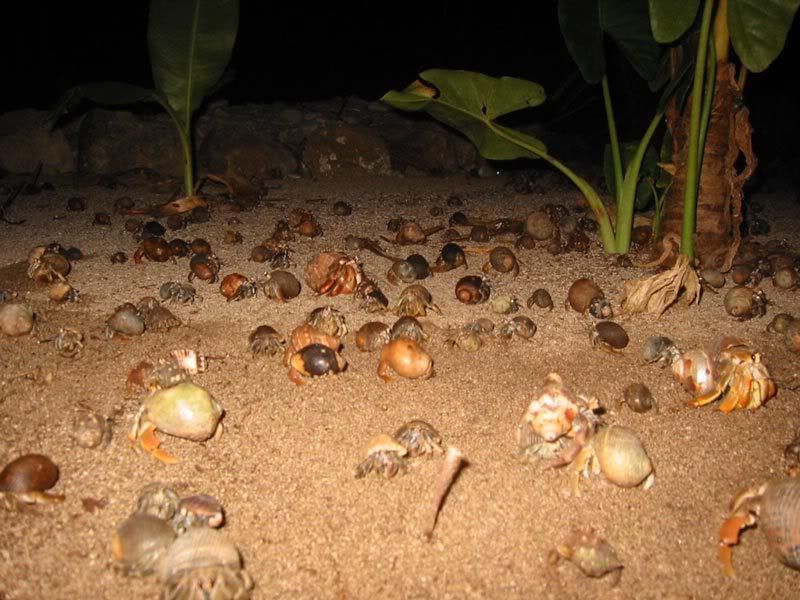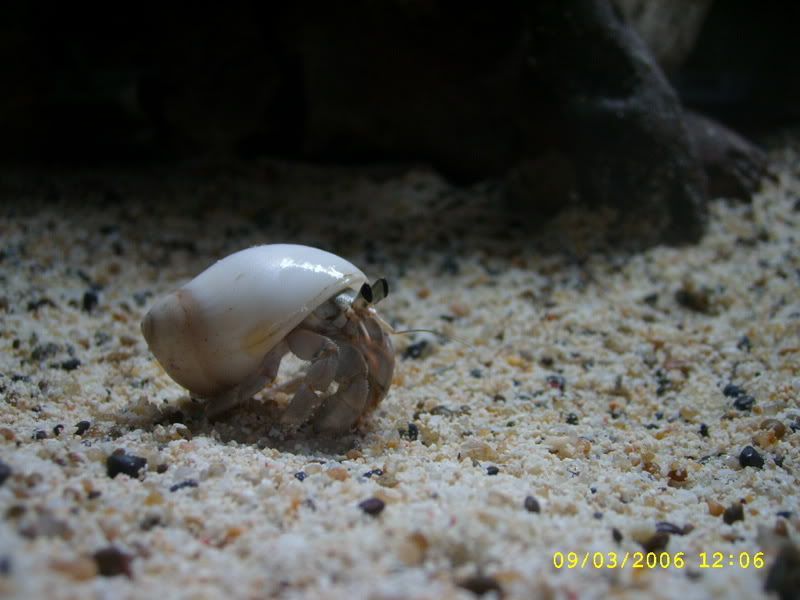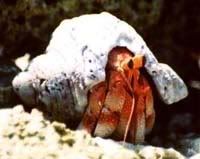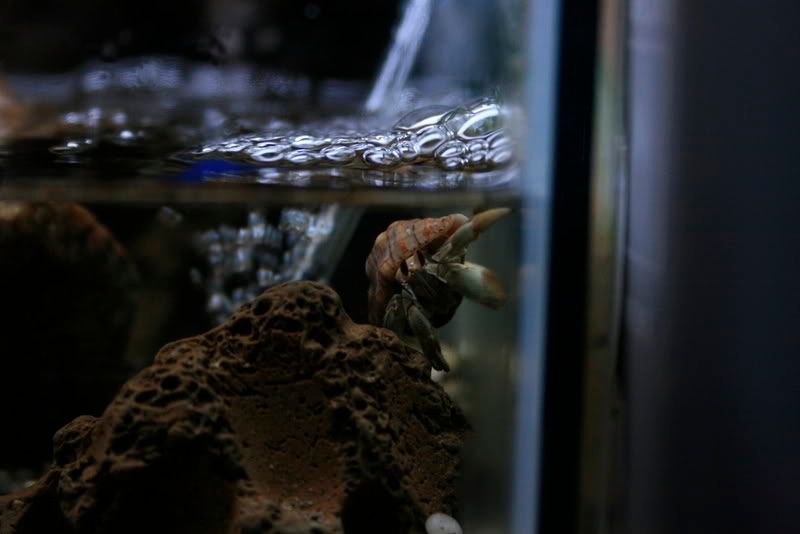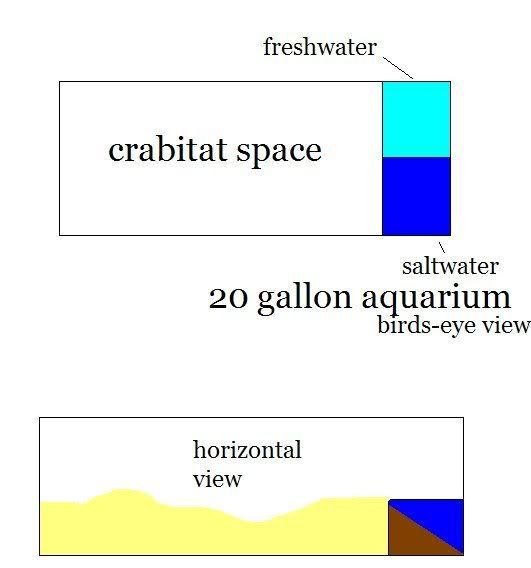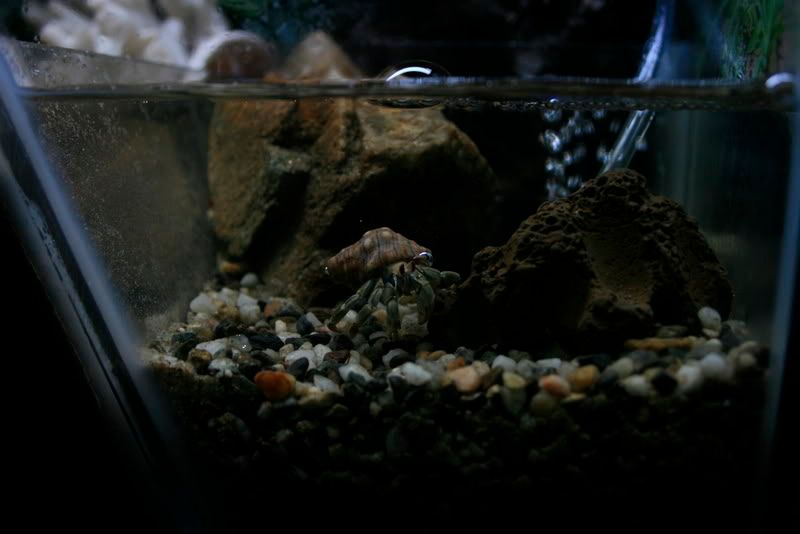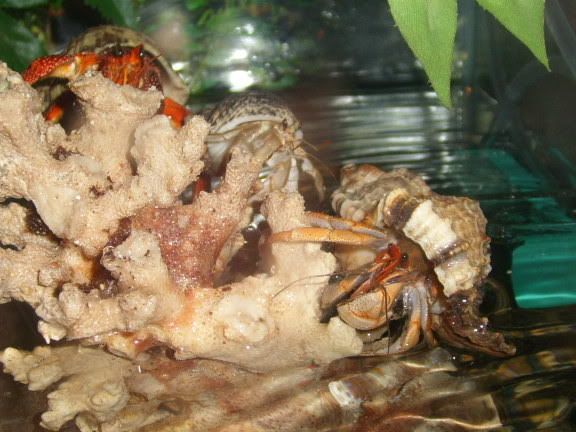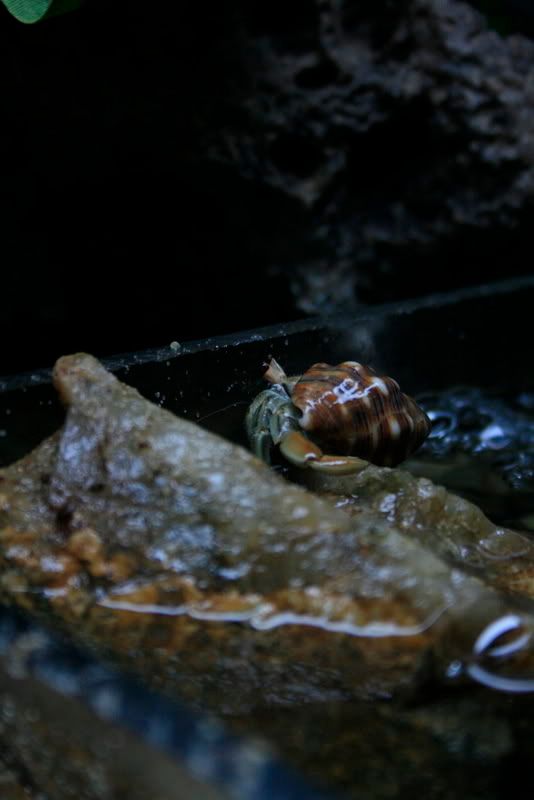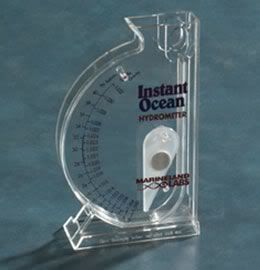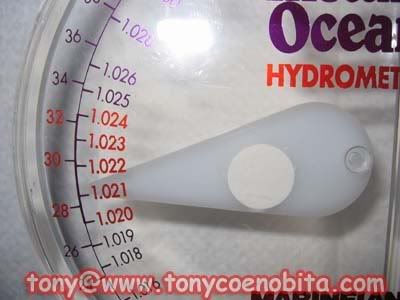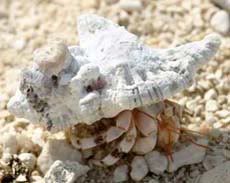 This very thought provoking article was published a few years ago on coenobita.org which unfortunately has 'disappeared' from the web. This revolutionary article discusses an effective way to reduce deaths from 'PPS' by slowy increasing the environment to suitable ranges. This theory was consulted with biologists and experts in the field to produce a scientifically correct way to increase the survival rate of newly purchased crabs.
This very thought provoking article was published a few years ago on coenobita.org which unfortunately has 'disappeared' from the web. This revolutionary article discusses an effective way to reduce deaths from 'PPS' by slowy increasing the environment to suitable ranges. This theory was consulted with biologists and experts in the field to produce a scientifically correct way to increase the survival rate of newly purchased crabs.
Enjoy.
Article: PPS: Minimizing the Impact ©2006, Coenobita Research
by Susan Latell
I have belonged to the on-line crabbing community for a little over 3 years now. From day one there was discussion about the number of deaths immediately occurring after purchase. It evolved into a named syndrome: PPS. Many “unexplainable” deaths that occurred in the time-frame from newly acquired to first post molt death were labeled PPS. Time lines wavered (anywhere from one week-up to one year), and alarmingly glossed over (in my opinion) too many other potential causes. The interesting aspect about this subject is that for all the debate that occurred, and the viable, if not absolute reasons offered, not one person or group was willing to agree or offer what to do to minimize it. What is more alarming about this is my own willingness to allow it to continue, even though I understand what PPS is! I think I have been maintaining PPS as an excusable reason for me to have a death in my population. It is important to me to be, or at least appear to be competent in the care of our charges. So grudgingly I have to admit that my complacency in not wanting to clearly define and action PPS, is so that I have a contingent reason to remain blameless for their death. It has been and is treated like this big mystery that there is no obtainable solution to! Well I think it is time to recognize what PPS is, as I am pretty sure we have had the answers at hand for some time!
The purpose of this article is to define what we know PPS to be TODAY; as we can understand its cause and is supported by the knowledge we have documentation for. We can amend standard care practices at this minute. That said, this definition should and will be refined as our successes and information on crabs grows. This is a first step to taking rightful responsibility for this type of crab death. There is a somewhat tested solution to this (if at this point, only by me) that I hope will evolve into an observed and practiced tactic. Please also refer to the companion article:
What is PPS?
PPS is the result of a crab’s inability to physiologically adapt quickly enough from his natural circumstances (environment and habits) into a transitional one and then into a captive environment. The inability to adapt is invoked and influenced by the degree of and withholding of elements the crabs need to adjust to their environment.
This statement means that crabs suffer the most risk of physical stress induced death from the change in their environment (heat, humidity, range and associated resources) by being harvested, shipped and housed by the pet merchants. Resources in this context are water, salt water, food and shelter. Explicitly we need to recognize that the stress is not an “emotional” one, which we have to tendency to relate more easily to. It is physical and involves their ability or inability to forage (for food); have access to resources such as salt water, fresh water; an appropriate substrate and/or room to metabolize to their new environmental surroundings (heat and humidity)! So what factors influence the potential for PPS?
Hermit crabs have remarkable stamina and can tolerate the extremity of their environmental changes for a certain amount of time. They also have built in metabolic processes that assist them in adjusting to their immediate environment. These include hibernation and respiratory regulation. These processes function when fueled appropriately by diet. Because they involve digestion and chemical adjustment, they take longer time to come into effect. Therefore, a rapidly changing environment can short circuit these process mechanisms. Another process, not quite of the same class is osmotic regulation. As long as there is physical access to water, crabs are immediately able to implement procedures to control temperature. This process is mostly reliant on water. A guide to understanding the time frame these processes can take for crabs to implement involves their initial health, their size, and how fluctuant the extremes are in occurrences and interval. All of these things by their very nature are aberrant! For example, a healthy crab can slow down his processes to accommodate a drop in temperature with minimal impact for about 7 days (the rough estimate it takes for a medium sized crab to ingest and process his last meal, plus exhaust immediate reserves). A lower humidity can also be accommodated in similar fashion. Water access does play a significant roll in this control mechanism, as well as for an over hot/humid situation. So if there is a lack of a key resource (water), or if the temperature they are kept at changes rapidly, they may be unable to sustain equilibrium for extended periods of time, especially if the crabs are not fed adequately. This inability does not immediately kill them, but the longer the duration of these types of events accrue, the more they become life threatening. This also explains why a crab may resort to cannibalism to survive!
The hardest part about determining if your crab may succumb to PPS is in the KNOWING if these circumstances were applicable to your crab’s journey to you. Well I can say with some measure of certainty that they would have had to endure significant change over at LEAST a 21 day period. That said, from some of the stories I have read on our forums, that time frame is modest! At some point in the future I will provide a more detailed accounting of what our crabs can go through to get to our pet stores, but for now let’s just focus on PPS.
Here is the really difficult point about PPS, and due to its nature, is probably the main reason we have continued to seek “reasons” outside of our control for PPS. Our NEW CRAB introductory practices! We pride ourselves on establishing and sustaining our interpretation of an “ideal” living environment for our crabs. Temperature and humidity are kept and monitored (by gauge) at the optimum levels (but not always in ranges>>bad, very bad). We for the most part provide the best in foods and offer both types of waters. Provide for hiding, climbing, digging, lighting; what more could our crabs possibly need and want in these circumstances? Why do they still die? Because we in our infinite wisdom think we have provided crab heaven! Well we missed an obvious problem. Not only have some of us taken on the belief that if we provide the right conditions crabs will recover just by what we provide, we have also ignored that crabs have the ability to adjust to their environment when they haven’t already been taxed to very extreme limits. This includes going from BAD environments to GOOD ones! We do not factor in what they have endured before getting to us, and we are quite strict in getting them into good ones as soon as possible. It seems that it is difficult for us even to conceive that we may be pushing them past their endurance level by moving them from that “Crab in a Cup” or dreaded mall kiosk, to a good crabitat set up.
Well in large part we are! We need to graduate them to the ideal conditions so their bodies and processes can catch up. How long can that take? Up to a month, and that is just strictly going by their ability to physically accommodate the change. What fuels that? Food taken in over time, waters and familiarity they gain in their surroundings. Then there is the possibility that they need to molt. Let’s hope they don’t have to for that first 30 day period. In my experience, molters that were new to my tanks suffered the greatest proportion of death! Death resulted 80% more then, than at any other time in my entire 6 year run!! The second month was a bit better at 30% death ratio, but after that it has (at least for me) been less than a 3% chance (at a 50 headcount) after 60 days.
So what are we supposed to do to prevent PPS?
Well while I am tempted to say that a procedure will “cure” almost all potential for PPS, it would be untrue. Since we have absolutely no control over when a crab is collected, or how long it has taken him to be collected, or have the experience to be able to with precision estimate at what point on the PPS scale an individual crab may be at, we have to generalize a treatment. We also cannot accurately factor in how people interpret heat and humidity, healthy diet and other handling aspects involved in overall crab husbandry.
So for the time being, PPS would be best addressed with a method that first allows for close observation by handlers, and secondly accommodates the crab’s ability to adjust to his immediate environment. So what does it take for these conditions to be utilized and what specifically does this mean?
The most important principal is GRADUATION of environmental conditions. Based on an average, calculated by scientists while they studied components of a hermit crab’s anatomical processes, they noted that it can take up to 96 hours for a crab collected and sampled directly from his native habitat to adjust to a change in environment. This is once the crab reaches his physiological threshold whereby hormonal triggers begin to occur. The hormonal regulation is fueled mostly by the crab’s food resources, but it also can include other regulatory systems. This means that a crab requires time to reduce physical stress by being able to adjust to his immediate circumstance. The greater the change, the less potential a crab has to adjust successfully, and co-dependent to time is the resources available to the crab either internally (through reserves), or externally in the form of food and water. Scientists have calculated that there is the highest successful adjustment when environmental changes occur in 5-7% increments. This means if they are adjusting temperature or humidity, they use the existing conditions as the constant, and use the percentage as the increment for adjustment. So how do we apply that to our method of introduction? By this:
1. Observe and recognize that your crabs are mostly leaving poor humidity and heat conditions. (Usually too high/low heat, and too low humidity) Also, food resources have probably (but not always) been limited, thus making the crab’s system “sluggish” and slow to respond to the change. See if they have had water vs. a sponge; note the approximate heat and humidity conditions and think of them in comparative terms to the ideal. Then establish a threshold (minimum tolerance level), that will be your starting point for readjusting crabs to the acceptable ranges.
This is not an exact process, because as you can already see, there can be several variables. I will provide an example, and after that I am afraid it will remain for the time being a function of trial and error, until we have more data in respect to successful outcomes. We will be measuring this by people providing key data that will be stored in a database. Once we tabulate “samples”, the increased number of samples will provide more accurate standards that we can provide as procedure to future situations.
2. We must utilize ISOLATION in a separate tank, where the environmental factors of heat and humidity is not PRESET at the ideal conditions. I have been concerned lately in the shift of thinking regarding the necessity of Isolation as part of the procedure for introduction. Far more focus has been placed on ISO being utilized for MOLTING. What I find frustrating about this, is that it is NOT necessary to do so in most circumstances. For re-acclimatizing stressed hermit crabs, it is! Please read the companion article
This is the sector where in the past I had remained flexible in terms of the duration of time we keep new crabs in isolation. That was when I was looking at it strictly from the perspective of general health and potential for bugs. What I was remiss in communicating, is that I have always as a practice kept new crabs in ISO for at least a month. In fact, it was rare that I move one to the main tank earlier even though they showed no indication of stress or contamination. The other important aspect of my ISO tank is that it is NOT at the same range in heat and humidity as my main population tanks. This was not immediately intentional; it came about from not being used! Why heat and humidify an empty tank?
Many of you already know that I do not advocate removal of pre-molt or molting crabs to isolation. So really my ISO has really only served as the transitional tank for new crabs, or as the treatment tank for sick ones. I think that initially this is why I had fewer occurrences of PPS, without knowingly doing it. My ISO built up to the ideal and equivalent main crabitat conditions over the period of time I kept them in ISO. I did not see the relationship until I consulted Peter about overheating issues and about dropped limbs. This was in early 2004. Principally what I learned about dropped limbs is that it was due to a stress induced shock caused by an extreme environmental change (that aspect was speculated and communicated already) and was just confirmed. The new information was that by controlling the extremity of the change, we would allow the crab to metabolically adjust less stressfully. It was outlined to me that changes in humidity and temperature should be gradually increased in percentage and in time to assist the crab. Or, at the very least , recognizing WHAT the differences in the crab’s initial environment were and adjusting the new conditions in relation to IDEAL conditions. I have shared this several times, especially when it was clearly explained by the owner how poor the previous conditions were. Consider this rationale: Remember reading at least once a story relating how a crab was able to survive DIRE conditions for up to a year and survive, only to die within weeks of being introduced to a “perfect” environment? Wouldn’t it stand to reason that the crab evolved to adjusting to his conditions to subsist in his environment if it occurred over an interval of time that his body could adapt to? Then we basically eliminated that interval to reverse the process, thus resulting in death. I saw immediately why this could be possible. Now you may understand too why I have been harping on maintaining “ranges” of temperature and humidity. It is because it can maximize the crab’s ability to adjust!
3. We must set a starting point for environmental conditions. If your crab comes from a pet store that has for example a heat lamp, no cover, no water, chances are that the approximate existing humidity range is 50% or lower. ASK how long the crabs have been in the store tank. If it has been more than 2 days, you will need to start at the lowest level that crabs can tolerate. That is 60% (with access to water and food), and a maximum tank temperature of 72 degrees. You would keep that level for a period of 72 hours and then increase it by 10% to 66%, and maintain that level for 72 hours, repeating the process until you match your main tanks average humidity level. This would take roughly 2 weeks if your target range was 79%. During this time crabs will need food to support the hormonal adjustment necessary to acclimate. Give them the fighting chance by not immediately moving them into a more competitive environment with your existing and healthier crabs! By sticking new crabs into a main population without benefit of isolation during their adjustment, you are diminishing the new crab’s ability to recover by increasing the resource competition level.
Temperature is not as significant to worry about; crabs use osmotic processes to control that! So their only need there is access to ocean salt water. It is the hormonally, or more accurately, the metabolically related processes that helps a crab adjust to humidity, and for that they need fuel and the time to process it. In effect this is how to minimize PPS.
Why is this not a fool proof cure?
This is the question that has held me back for some time. I wanted a definitive answer as to why PPS happened. It wasn’t until I looked at it in components that it became clear that while we can significantly reduce PPS, there will be circumstances that cannot be overcome. The ones I understand the most are:
1). Damage to gills from prolonged dehydration -
This condition thankfully is not too common, surfactants that the crab regurgitates from his digestive tract in order to self hydrate his gills, ultimately will result in death. There is nothing we can do if the conditions he endured drive him to this point.
2). Starvation-
While this seems to be one of the things we can combat more readily, if it has endured for a prolonged period of time, we may not be able to reverse the effects. A crab requires constant energy to sustain his metabolic changes. He may not be able to produce the necessary hormones to transition into his new environment. What’s imminently worse about this condition is that it can result in death for a crab that needs to molt, and remains a potential for causing molt death more typically, but not exclusively (depending on the crabs size) for the first few months of ownership.
3). Our humidity and temperature control-
Okay, I am prepared to deal with the flack I will get for blaming owners who fail to recognize the importance of maintaining temperature and humidity ranges. But there it is! There is an inherent mistake created when we relate heat and humidity in absolute terms! When we reply to inquiries with a comment like “set your heat and humidity to 80/80 and you can’t go wrong”, well, we do! While 80/80 is within the tolerable ranges, it does not communicate that these settings are the higher end of the range, and that there is and should be other temperatures and humidity levels within the crabitat. I realize that this occurs more out of a convention of speech and is not meant to mislead people. The sad reality is that people (especially new crabbers) take these stated levels literally and they worry and painstakingly try to achieve this exact ratio. What worries me about this is that we need to recognize AND COMMUNICATE that a crabitat should have RANGES of heat and temperature. The people saying that 80/80 produces active healthy crabs are not totally wrong (I just hate the way it is expressed because it gets misconstrued)…it is the “Way” it is interpreted when we use such an explicit example. We cannot show that the loftier areas will be lower in humidity but higher in heat…just like the middle of the tank will be closer to the true 80/80…and that the lower regions will be even more skewed temperature wise over the UTH (if there is one), below the lamp etc…so how can we communicate these acceptable ranges without creating a pseudo class that people use really by convention of speech and lack of full understanding how humidity and temperature work? It gets into dangerous ground when we say “oh Straws like the humidity at 85%”…well many of us do not segregate our tanks by species…and an E or PP may overheat when a tank is that oversaturated!
I feel this aspect contributes greatly to crab death in general, and not just from the PPS perspective. Though it is related in the sense that we diminish our crab’s ability to adjust by not providing differences that our crabs can utilize! They are in a tank people! There is no comparison to their natural habitat where there is wind and tidal influences, ground cover, and the fact that they can move to utilize these resources at their whim, and instinct! We NEED to provide for that! I trust my own experience in this, and I admit I have never had an “unexplained” death 6 months to 1 year after getting them. So rather blatantly, I don’t think it is acceptable to define PPS over such a broad time-frame! I have had a couple of puzzling deaths, and I attribute it more to me not providing them with the proper foods, or the proper balance of adequate diet, and maybe even possibly poisoning them, than the soon to be dispensed idea that it is PPS! We need to call a spade a spade, or we are in danger of remaining blissfully, and BLAMEFULLY ignorant of real issues that we could resolve! I am ashamed that until a short while ago, I was willing to ignore the significant realization that WE are a component of PPS. I trust the results I have had over the years, and have now filled in the reasons (started by dumb luck, and now more understood) due to valuable information I learned from reading and discussing with experts the physical processes our crabs are capable of. Now it is time to use the information and change our methods!
So what will the new time defined extent of PPS related deaths be?
For now, until we amass actual numbers, I think my model that I accrued when taking in adopted crabs, and purchased new crabs will be used (a total of 117 over 2 years). That means that potential PPS deaths will defined for at least 30 days from original ownership date up to and including the first molt. This will be conditioned by the fact that if a molt occurs after the first 60 days (being the highest risk for PPS related death), then the death may be more attributed to a lack within the owners environment, not necessarily PPS. The factors used to qualify these latent molts will be crab size and review of the owner’s food list and environmental conditions!
Overview
PPS is Death as a result of a crab being deprived of the conditions and resources he needs to adapt to changes in his environment. We are part of that change. We can minimize PPS death by practicing ISOLATION and a GRADUATED increase to ideal crabitat conditions over a period of time to offset the poor conditions crab harvesting can create. These changes should occur in stages that the crab’s physical processes can accommodate. We need first to acknowledge the crabs own capability to adjust, and synchronize the environmental adjustments to their metabolic time frame. Death of a crab should not be classified as PPS outside of the initial established time frame of adjustment (30 days), unless there is a molt occurring within a 60 day time frame. After 60days, a case by case assessment should be done, and evaluated based on the crab’s size, on the conditions he came from, and from the examination of existing diet and environmental factors (heat and humidity). While PPS will be definite within the 30 day period, that likelihood in classification diminishes as time increases.
Implementation Recommendations:
This definition will be amended by statistical evaluation, and new study material. I recommend review in the process be conducted in 90 days time and that a committee be established in evaluating collected data. A permanent template with fixed element names should be used to feed the database for this data collection category: PPS.
Concurrent to this study, an evaluation of the specific accepted time frame for PPS to be considered a cause should be presented to crab care communities by poll. It should be encouraged that members also support their choice with their personal reasoning. This will then be used to help the committee establish the recognized and formally accepted time interval for decreeing PPS as the cause of death.
Article: PPS: Minimizing the Impact ©2006, Coenobita Research
Written by: Susan Latell
Last Edited: 3/09/2006
---------------------------
While I personally do not use this exact technique for my own tank , It is a very effective way to reduce PPS deaths, I highly recommended it to the beginner and experienced hobbyist alike.
Cheers.
